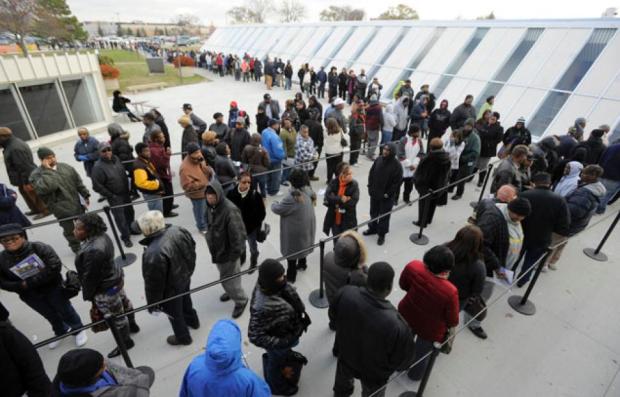
Photo of long voting line via NY Daily News
I left my California beach town vacation early to return to frozen New York for the democratic tradition and right of jury duty. For two days, I sat in a stale room with intermittent wifi with over 100 citizens from across socio-economic backgrounds. Unfortunately, what should’ve been a privileged and proud citizen experience turned out to be a futile, inefficient, and outdated process. I say this not to diminish the importance of diverse citizen juries, but to acknowledge the frustration I saw and heard from my fellow citizens in the room, and experienced myself. At the end of the second day, my peers and I cheered and sighed in relief as we heard that we are free from serving on a jury for the next several years. I was at once thrilled that I was done with what was a dreaded and annoying process, and saddened that most citizens would leave the court house with even less confidence or interest in their government.
“As a country, we haven’t invested in or changed the ways we engage with democracy; we’re interacting with 20th century institutions in the 21st century.”
A graduate student in public policy, I’ve been involved with government since high school. What struck me as I sat in the jury room is that while I’ve interacted with the government in many ways as an employee, student, and engaged citizen, for many in the room, this is one of the only times they’ll interact with the government this year, and they were left sorely disappointed in how it functions.
Jury duty, the DMV, and voting are some of the main ways citizens interact with their government. These citizen-facing services are key opportunities for government to increase citizen confidence and happiness, and yet, they are often the most complained about and despised. Citizens have low expectations of a government that’s hampered by general inertia, and are becoming more apathetic, angry, or both. Citizen confidence in Congress is at an all-time low, with only 7% of citizens having “a great deal” of confidence in Congress. A McKinsey survey on government customer service found the disturbing fact that “citizens were less satisfied with many government services than with cable- or satellite-TV services.” When you like your cable company more than your government, you know there’s a problem.
When it comes to going to jury duty, the DMV, or voting, long lines, confusing processes, and inefficiency often mark the citizen experience. And too often, citizens from minority and/or low-income backgrounds are disenfranchised from or experience even more difficulty participating. Citizens aren’t necessarily looking forward to the next time they have to show up for jury duty, renew a license, register to vote, or cast a ballot. As a country, we haven’t invested in or changed the ways we engage with democracy; we’re interacting with 20th century institutions in the 21st century.
But it doesn’t have to be that way. There are innovation teams popping up in cities across the country and in the Federal government to bring creative solutions and refined processes to government problems. While that’s a start, to increase citizen confidence, the teams need to focus on certain aspects of service delivery. It’s important for civic innovators to differentiate between internal and external changes. While a service like the DMV can increase their internal performance and efficiency, citizen confidence won’t increase unless the citizen-facing experience is also improved. Just like customer service has become central to a business’s success, citizen experience should be central to government reforms.
When you like your cable company more than your government, you know there’s a problem.
Federal, state, and local governments can look to increase citizen confidence and civic participation if they take notes from human-centered design for in-person processes, and user-experience and user-interface design for their online platforms. The Office of New Urban Mechanics in Boston and Philadelphia, Bloomberg i-teams, Code for America, Presidential Innovation Fellows, and the Federal government’s 18f are making progress in these areas, but they are still few and far between. Until governments start to take citizen experience seriously, citizens will continue sighing in relief that they don’t have to interact with their government again for a few years. And that’s just a shame.